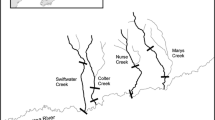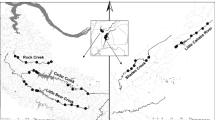Abstract
A major limitation of methods for collecting small fish and shrimp is that no single method is equally effective for all species or all life history stages. We compared the efficacy of the sweep net electrofishing (SNE) method with two other commonly used sampling methods for the collection of small fish and shrimp, the standard sweep net (SW) and the point abundance electrofishing (PAE) method developed by Copp & Penaz (1988). The effectiveness of the three methods was compared under three different current speeds in an Australian lowland river. The SNE method collected an order of magnitude more shrimp and a greater size range than the other two methods, irrespective of the current speed. The SNE method captured a similar number of fish to the SW method, but significantly more individuals than the PAE method. However, the two electrofishing methods caught a greater size range of both fish and shrimp than did the SW method. The effectiveness of the SNE method appears to be due to its ability to immediately capture shocked individuals, thereby lessening the likelihood of escape. Whilst the SNE method is not quantitative, its high level of effectiveness is likely to be particularly useful in systems with low densities of fish and shrimp.
Similar content being viewed by others
References
Boulton, A. J. & M. A. Brock, 1999. Australian Freshwater Ecology: Processes and Management. Gleneagles Publishing, Australia: 300 pp.
Brosse, S., S. Gabas, K. Cever & S. Lak, 1999. Comparison of two point abundance sampling methods to assess young roach (Rutilus rutilus L.) microhabitat in the littoral zone of Lake Pareloup (France). Ann. Limnol. 35: 199–204.
Collins, P. A. & J. C Paggi, 1988. Feeding ecology of Macrobrachium borelli (Nobili) (Decapoda: Palaemonidae) in the flood valley of the River Parana, Argentina. Hydrobiologia 362:21–30.
Copp, G. H., 1989. Electrofishing for fish larvae and O+ juveniles: equipment modifications for increased efficiency with short fishes. Aqua. Fish. Mgmt. 20:453–462.
Copp, G. H., 1992a. An empirical model for predicting microhabitat of 0+ juveniles in a lowland river catchment. Oecologia 91:338–345.
Copp, G. H., 1992b. Comparative microhabitat use of cyprinid larvae and juveniles in a lotic floodplain channel. Env. Biol. Fishes. 33:181–193.
Copp, G. H. & M. Penaz, 1988. Ecology of fish spawning and nursery zones in the flood plain, using a new sampling approach. Hydrobiologia 169:209–224.
Copp, G. H. & P. Garner, 1995. Evaluating microhabitat use of fish larvae and juveniles with point abundance sampling. Fol. Zool. 44:145–158.
Copp, G. H., G. Guti, B. Rovny & J. Cerny, 1994. Hierarchical analysis of habitat use by 0+ juvenile fish in Hungarian/Slovak flood plain of the Danube River. Environ. Biol. Fish. 40: 329–348.
Fiévet, E., 1999. An experimental survey of freshwater shrimp upstream migration in an impounded stream of Guadeloupe Island, Lesser Antilles. Arch. Hydrobiol. 144:339–355.
Fiévet, E., L. Tito de Morias & A. Tito de Morais, 1996. Quantitative sampling of freshwater shrimps: comparison of two electro-fishing procedures in a Caribbean stream. Arch. Hydrobiol. 138: 273–287.
Fiévet, E., P. Bonnet-Arnaud & J. P. Mallet, 1999. Efficiency and sampling bias of electrofishing for freshwater shrimp and fish in two Caribbean streams, Guadeloupe Island. Fish. Res. 44:149–166.
Fouilland, E. & O. Fossati, 1996. Trapping efficiency of plastic bottle ‘wickertraps’ for population assessment of river Macrobrachium (Crustacea: Decapoda). Fish. Res. 28:343–351.
Fouilland, E.& O. Fossati, 1998. Effects of some operational factors on Macrobrachium (Decapoda, Palaemonidae) sampling using small ‘wickertraps’. Fish. Res. 34:87–92.
Garner, P., 1996. Microhabitat use and diet of 0+ cyprinid fishes in a lentic, regulated reach of the River Great Ouse, England. J. Fish. Biol. 48:367–382.
Garner, P., 1997. Sample sizes for length and density estimation of 0+ fish when using point sampling by electrofishing. J. Fish. Biol. 50:95–106.
Gozlan, R. E., S. Mastrorillo, F. Dauba, J. Tourenq & G. H. Copp, 1998. Multi-scale analysis of habitat use during late summer for 0+ fishes in the River Garonne (France). Aquat. Sci. 60:99–117.
Hancock, M. A. & S. E. Bunn, 1997. Population dynamics and life history of Paratya australiensis Kemp, 1917 (Decapoda: Atyidae) in upland rainforest streams, south-eastern Queensland, Australia. Mar. freshwat. Res. 48:361–369.
Hayes, D. B., C. P. Ferreri & W. W. Taylor, 1996. Active fish capture methods. In Murphy, B. R. & D. W. Willis (eds), Fisheries Techniques. 2nd edn. American Fisheries Society, Marysland: 193–220.
Hill, T.J., & D.W. Willis, 1994. Influence of water conductivity on pulsed AC and pulsed DC electrofishing catches for largemouth bass. N. am. J. Fish. Manag. 14:202–207.
Holmquist, J. G., J. M. Schmidt-Gengenbach & B. B. Yoshioka, 1998. High dams and marine-freshwater linkages: effects on native and introduced fauna in the Caribbean. Cons. Biol. 12: 621–630.
Humphries, P. & P. S. Lake, 2000. Fish larvae and the management of regulated rivers. Regulated Rivers: Res. Mgmt. 16:421–432.
Humphries, P., L. G. Serafini & A. J. King, In press. River regulation and fish larvae: variation through space and time. Freshwat. Biol.
Jurajda, P., 1999. Comparative nursery habitat use by 0+ fish in a modified lowland river. Regulated Rivers: Res. Mgmt 15:113–124.
Kelso, W. E. & D. A. Rutherford, 1996. Collection, preservation, and identification of fish eggs and larvae. In Murphy, B. R. & D. W. Willis (eds), Fisheries Techniques. 2nd edn. American Fisheries Society, Marysland: 255–302.
Lake, J. S., 1967. Rearing experiments with five species of Australian freshwater fishes. II. Morphogenesis and ontogeny. Aust. J. mar. Freshwat. Res. 18:155–173.
Lightfoot, G. W. & N. V. Jones, 1996. The relationship between the size of 0+ roach, Rutilus rutilus, their swimming capabilities, and distribution in an English river. Fol. Zool. 45:355–360.
McDowall, R. M. (ed.), 1996. Freshwater Fishes of South-Eastern Australia. 2nd edn. Reed Books, Sydney: 247 pp.
Meng, L., 1993. Sustainable swimming speeds of striped bass larvae. Trans. am. Fish. Soc. 122:702–708.
Neira, F. J., A. G. Miskiewicz & T. Trnski, 1998. Larvae of temperate Australian fishes. Laboratory guide for larval fish identification. University of Western Australian Press, Perth: 272 pp.
Nelva, A., H. Persat & D. Chessel, 1979. Une nouvelle méthode d'étude des peuplements ichtyologiques dans les grands cours d'eau par échantillonnage ponctuel d'abondance. C. R. acad. Sci. Paris 289:1295–1298.
Odinetz-Collart, O. & C. Magalhaes, 1994. Ecological constraints and life history strategies of palaemonid prawns in Amazonia. Verh. int. Ver. Limnol. 25:2460–2467.
Penczak, T. & G. Rodriguez, 1990. The use of electrofishing to estimate population densities of freshwater shrimps (Decapoda, Natantia) in a small tropical river, Venezuela. Arch. Hydrobiol. 118:501–509.
Regis, J., E. Pattee & J. D. Lebreton, 1981. A new method for evaluating the efficiency of electric fishing. Arch. Hydrobiol. 93: 68–82.
Reynolds, J. B., 1996. Electrofishing. In Murphy, B. R. & D. W. Willis (eds), Fisheries Techniques. 2nd edn. American Fisheries Society, Marysland: 221–253.
Schiemer, F., T. Spindler, H. Wintersberger, A. Schneider & A. Chovanec, 1991. Fish fry associations: important indicators for the ecological status of large rivers. Verh. int. Ver. Limnol. 24: 2497–2500.
Walker, I. & M. J. N. Ferreia, 1985. On the population dynamics and ecology of shrimp species (Crustacea, Decapoda, Natantia) in Central Amazonian river Tarumã-Mirim. Oecologia 66:264–270.
Watkins, M. S., S. Doherty & G. H. Copp, 1997. Microhabitat use by 0+ and older fishes in a small English chalk stream. J. Fish. Biol. 50:1010–1024.
Williams, W. D., 1980. Australian Freshwater Life. The invertebrates of Australian inland waters. Macmillan, Melbourne: 321 pp.
Williams, W. D., 1977. Some aspects of the ecology of Paratya australiensis (Crustacea: Decapoda: Atyidae). Aust. J. mar. Freshwat. Res. 28: 403–415.
Wintersberger, H., 1996. Spatial resource utilization and species assemblages of larval and juvenile fishes. Arch. Hydrobiol. Supp. 115: 29–44.
Author information
Authors and Affiliations
Rights and permissions
About this article
Cite this article
King, A., Crook, D. Evaluation of a sweep net electrofishing method for the collection of small fish and shrimp in lotic freshwater environments. Hydrobiologia 472, 223–233 (2002). https://doi.org/10.1023/A:1016307602735
Issue Date:
DOI: https://doi.org/10.1023/A:1016307602735




